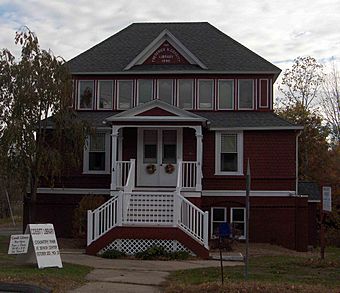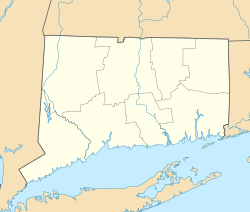Frederick H. Cossitt Library facts for kids
Quick facts for kids |
|
|
Frederick H. Cossitt Library
|
|
 |
|
| Location | 388 N. Granby Rd., Granby, Connecticut |
|---|---|
| Area | 0.3 acres (0.12 ha) |
| Built | 1890 |
| Architect | Sibley, Jasper Daniel; Greene, T.J. |
| Architectural style | Queen Anne |
| NRHP reference No. | 88000708 |
| Added to NRHP | June 22, 1988 |
The Frederick H. Cossitt Library is a special old building in Granby, Connecticut. It was built in 1890 and has a beautiful style called Queen Anne. A talented architect named Jasper Daniel Sibley designed it.
This library was made possible by a generous gift from Frederick H. Cossitt. He was a rich businessman from New York who grew up in Granby. The library was also strongly supported by George S. Godard, who later became a very important librarian for the state of Connecticut. The Frederick H. Cossitt Library is so important that it was added to the National Register of Historic Places in 1988. Today, it still serves as a branch of Granby's public library system.
What Does the Library Look Like?
The Frederick H. Cossitt Library is located in North Granby. You can find it where East Street (Connecticut Route 539) and North Granby Road (Connecticut Route 189) meet. It is a two-story building made of wood. The first floor is covered in brick, and the second floor has wooden siding.
The roof is shaped like a hip, which means it slopes down on all sides. It has a tall window area in the middle called a clerestory. The main door is on the second floor. A pretty porch with a pointed roof covers the entrance. This porch is held up by square columns. The brickwork and other details show off the fancy Queen Anne style.
A Look at the Library's History
This library was the very first one in Granby. It was built in 1890 and is one of the best examples of Queen Anne architecture in the town. George S. Godard was a big part of making it happen. He was a trustee for the town library while still studying at Wesleyan University. Godard then became the library's first librarian. He went on to have a long and successful career as the state librarian for Connecticut.
The money for the library came from Frederick H. Cossitt. He was a wealthy businessman from New York City. His family had lived in Granby since the mid-1700s. His gift helped create this important place for learning and reading in the community.



